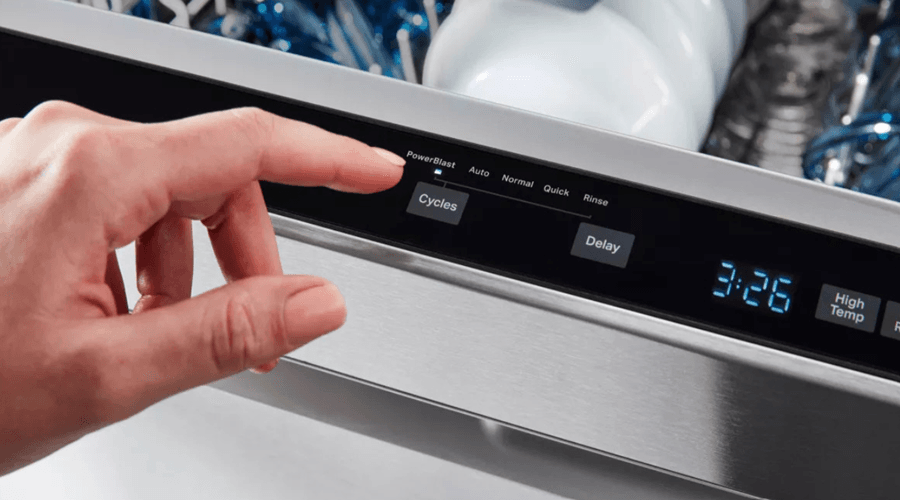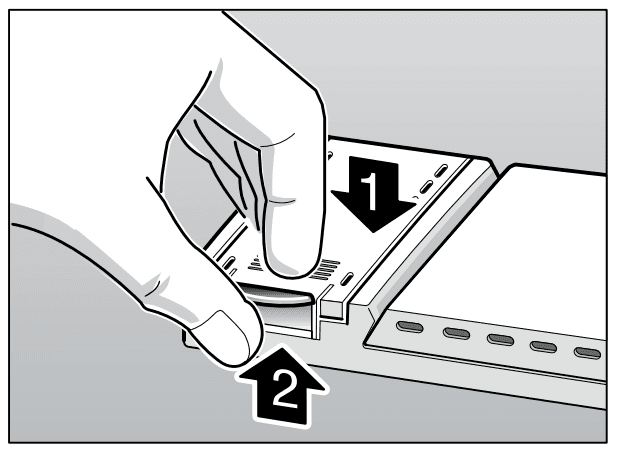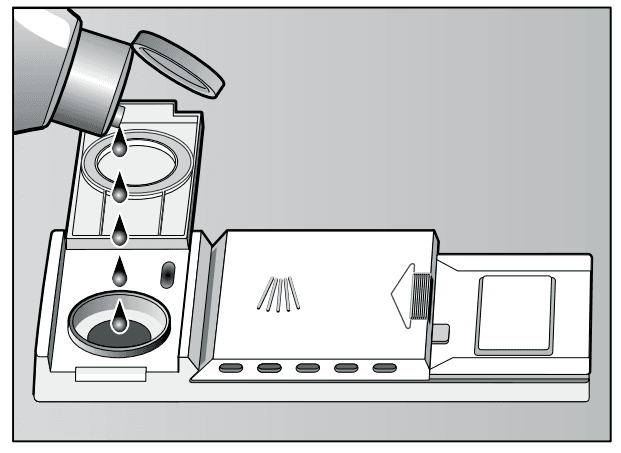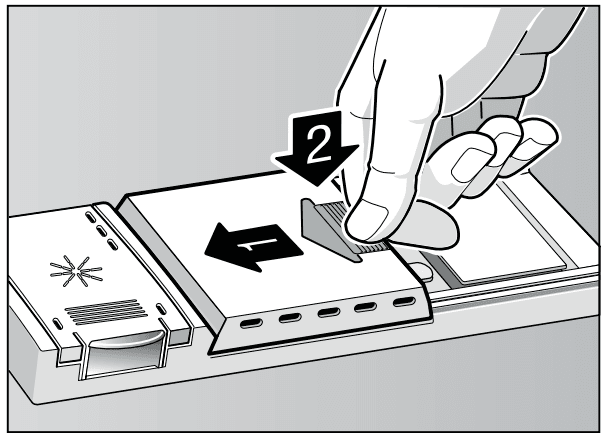
Bosch Dishwasher
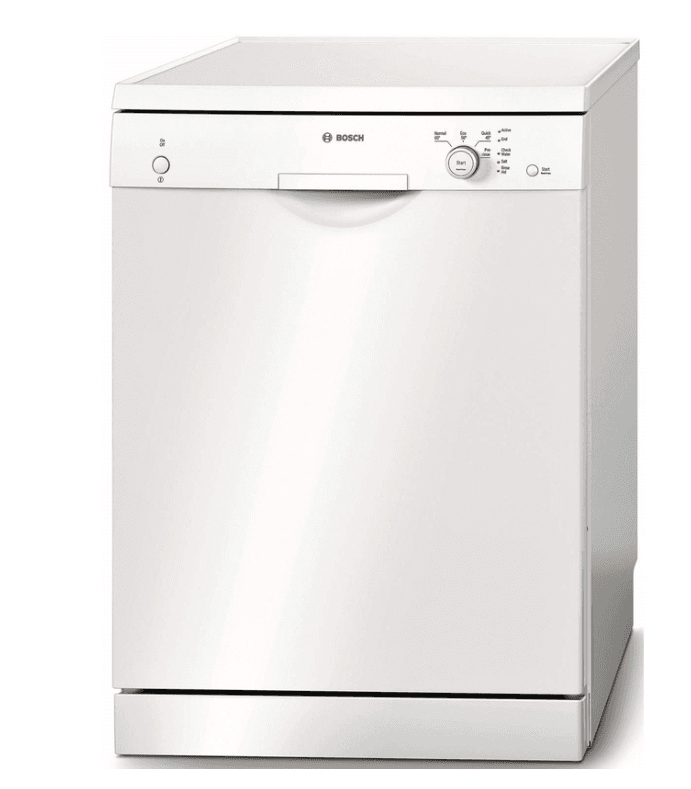
Before you switch ON the appliance
Please read the operating and installation instructions carefully. They contain important information on how to install, use, and maintain the appliance. Retain all documents for subsequent use or for the next owner.
Delivery
- Check the packaging and dishwasher immediately for damage caused in transit. Do not switch on a damaged appliance, but contact your supplier.
- Please dispose of the packaging material in an environmentally friendly manner.
- Do not let children play with the packaging and its parts. There is a risk of suffocation from collapsible boxes and film.
Installation
Read the “Installation” chapter to learn how to install and connect the appliance correctly.
In daily use
- This appliance is intended for use in the home and the home environment.
- Use the dishwasher only in the household and only for its designed purpose: for washing
domestic dishes. - Children or people whose physical, sensory or mental abilities prevent them from using the appliance safely must not use this appliance without supervision or instruction by a responsible person.
- Do not lean or sit on the open door. The appliance could tip.
- Please note that free-standing appliances may tip over if the baskets are overloaded
- Do not add any solvents to the washing chamber. The danger of explosion!
- Open the door carefully when the program is still running. There is a risk of hot water spraying
out of the appliance. - To prevent injuries, e.g. caused by stumbling, open the dishwasher only briefly in order to load and unload the dishwasher.
- Read and observe the safety information and instructions for use on the packaging for cleaning and rinsing agents.
Children in the household
- If fitted, use the childproof lock. An exact description can be found in the back of the envelope.
- Do not allow children to play with or operate the appliance.
- Keep children away from detergents and rinse aid. These may cause chemical burns in the mouth, throat, and eyes or asphyxiation.
- Keep children away from open dishwashers. The water in the rinsing compartment is not drinking water and could contain detergent residue.
Childproof lock (door lock)Dor lock *
The description of the childproof lock is at the back of the envelope.
* depending on the model Childproof lock (button lock)Buton lock You can secure your appliance from unintentionally being the programme terminated (e. g. improper operation by children)
Activating the button lock:
- Start the required program.
- Hold down the button B for approx. 4 sec. until ’CL is indicated on the digital display. If any button is pressed while the program is running, ’CL is indicated on the digital display. It is not possible to end (Reset) the program.
Deactivating the button lock:
- Hold down the button B for approx. 4 sec. until the display ’CL goes out.
When the program ends (0 on the digital display), the button lock is cancelled. If there is a power failure, the button lock is retained. Whenever a program is restarted, the button lock must be reactivated.
Damage
- The appliance may be repaired and opened up by a technician only. To do this, disconnect the appliance from the power supply. Pull out the mains plug or switch off the fuse. Turn off the tap.
Disposal
- Make redundant appliances unusable to prevent subsequent accidents.
- Dispose of the appliance in an environmentally friendly manner.
Getting to know your appliance
Diagrams of the control panel and the interior of the appliance can be found in the envelope at the front.
Individual positions are referred to in the text.
Control panel
- Main switch
- Door opener
- Digital display
- Timer programming *
- Additional options **
- Salt refill indicator
- Rinse aid refill indicator
- Display “Check water supply”
- Program buttons **
* depending on model
** Number depending on model
Appliance interior
- 20 Top basket
- 21 Knife shelf *
- 22 Top spray arm
- 23 Bottom spray arm
- 24 Dispenser for special salt
- 25 Filters
- 26 Cutlery basket
- 27 Bottom basket
- 28 Lock for detergent dispenser
- 29 Dispenser for rinse aid
- 30 Detergent dispenser
- 31 Rating plate
* depending on model
Water softening system
To ensure good washing results, the dishwasher requires soft water, i.e. containing low amounts of lime, otherwise, white limescale will be deposited on the utensils and inner container. Tap water above 9° Clarke must be softened. The water is softened with salt (regeneration salt) in the dishwasher’s water softening system. The setting and therefore the required amount of salt depends on the degree of hardness of your tap water (see table).
Setting
The amount of salt dispensed can be set from 0 to 7. Sal is not required at the set value of 0.
- Find out about the hardness value of your tap water. Your water utility company will help you with this.
- The set value can be found in the water hardness table.
- Close the door.
- Hold down program button B and switch on the main switch 1
- Release both buttons. The LED for button B flashes and the digital display 3 displays the factory setting 4.
To change the setting:
- Press program button B. Each time the button is pressed, the set value increases by one level;
when the value 7 has been reached, the display jumps back to 0 (off). - Switch off the main switch 1 The chosen setting has now been stored.
Water hardness table
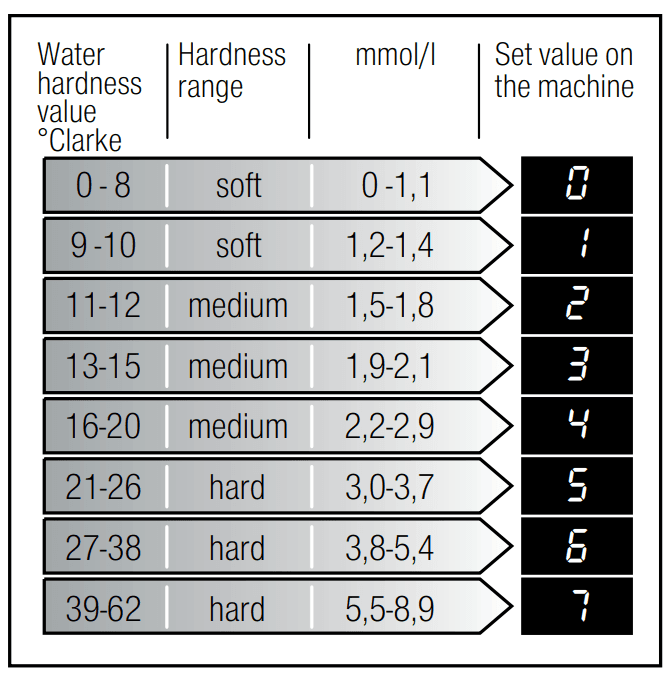
Special salt
Using special salt
Always refill with special salt immediately before switching on the appliance. This ensures that the overrun special salt solution is immediately washed out and does not corrode the rinsing tank.
- Open the screw-type cap of compartment 24.
- Fill the tank with water (only required when switching on the appliance for the first time).
- Then add salt (not table salt).
The water is displaced and runs out.
The salt refill indicator 6 on the fascia is lit. It goes out as soon as a sufficiently high salt solution has formed. If the set value 0 is displayed, do not add any salt because salt will not be used during the operation of the appliance, the salt display is switched off. If the set values 1 to 7 are displayed, salt must be added.
Using detergents with salt component
If combined detergents with a salt component are used, salt can usually be omitted up to water hardness of 21° dH (37° fH, 26° Clarke, 3.7 mmol/l). If the water hardness is over 21° dH, special salt must be used.
Salt refill indicator
As soon as the salt refill indicator 6 on the fascia is lit, top up the salt. Depending on the washing frequency and the hardness setting, the regeneration salt may not have to be topped up for several months. If the salt refill indicator 6 is impaired (e. g. when using combined detergents containing salt components), it can be switched off.
- Proceed as described under “Setting water softening system” and set the value to 0. The water softening system and salt refill indicator are now switched off.
Rinse aid
As soon as the rinse-aid refill indicator 7 is lit on the fascia, there is still a rinse-aid reserve of 1–2 rinsing
processes. Refill with rinse aid. The rinse aid is required for stain-free utensils and clear glasses. Use only rinse aid for domestic dishwashers. Combined detergents with rinse-aid components may be used up to water hardness of 21° dH (37° fH, 26° Clarke, 3.7 mmol/l) only. If the water hardness is over 21° dH, a rinse aid must be used.
- Open the cover on the rinse-aid dispenser 1j. To do this, press the mark (1) on the cover and simultaneously lift the cover on the control plate (2).

- Carefully pour in the rinse aid to just below the edge of the filler opening.

- Close the cover until it clicks shut.
- To prevent excessive foam formation during the next rinse cycle, remove any rinse aid that has run over with a cloth.
Setting the amount of rinse aid
The rinse aid dispensing rate can be adjusted steplessly. The clear rinse controller was set to 4 at the factory. Do not change the position of the rinse aid control unless there are streaks (rotate towards –) or water stains (rotate towards +) on the utensils.
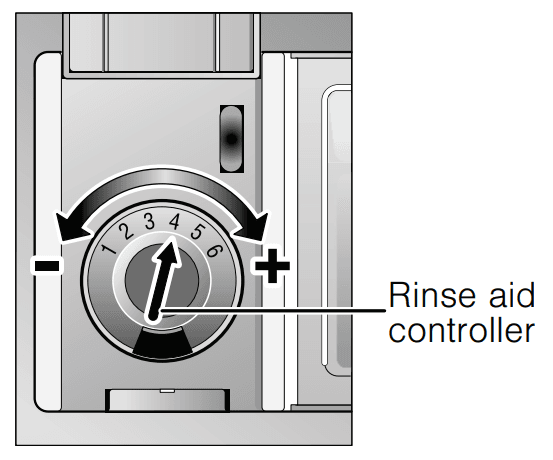
Switching the rinse aid refill indicator off or on
If the rinse-aid refill indicator 7 is impaired (e.g. when using combined detergents containing rinse aid
component), it can be switched off. To change the setting:
- Close the door.
- Hold down program button c and press main switch 1 until the digital display8 illuminates.
- Release buttons. On the digital display, 3 ‚ is indicated (rinse-aid refill indicator on).
- By pressing button C you can switch the rinse-aid indicator off 0 or on ‚.
- Switch off the main switch 1 the chosen setting has now been stored.
Utensils
Not suitable
- Cutlery and utensils made of wood.
- Delicate decorative glasses, craft, and antique utensils. These decors are not dishwasher-proof.
- Plastic parts are not resistant to heat.
- Copper and tin utensils.
- Utensils that are soiled with ash, wax, lubricating grease, or ink.
Aluminum and silver parts have a tendency to discolor and fade during the wash cycle. Even some types of glass (e.g. crystal glass objects) may turn cloudy after many wash cycles.
Glass and utensil damage
Causes:
- Glass type and glass production process.
- Chemical composition of the detergent.
- Water temperature of the wash program.
Recommendation:
- Use only glasses and porcelain which the manufacturer designates as dishwasher-proof.
- Use a detergent that protects utensils.
- Take glass and cutlery out of the dishwasher as soon as possible after the program ends.
Loading the dishwasher
- Remove large food remnants. It is not necessary to pre-rinse utensils under running water.
- Place the utensils so that
- they are secure and cannot tip over.
- all utensils with their openings face down.
- parts with curves or indentations are at an angle, thereby allowing water to drain.
- does not obstruct the rotation of the two spray arms 22 and 23 Very small utensils should not be washed in the machine, as they may fall out of the baskets.
Unloading the dishwasher
To prevent water from dripping off the upper basket onto the utensils in the lower basket, it is recommended to empty the appliance from the bottom up. Hot utensils are sensitive to shock! Therefore, when the program ends, leave the utensils to cool down in the dishwasher until they can be handled.
Cups and glasses
Top basket 20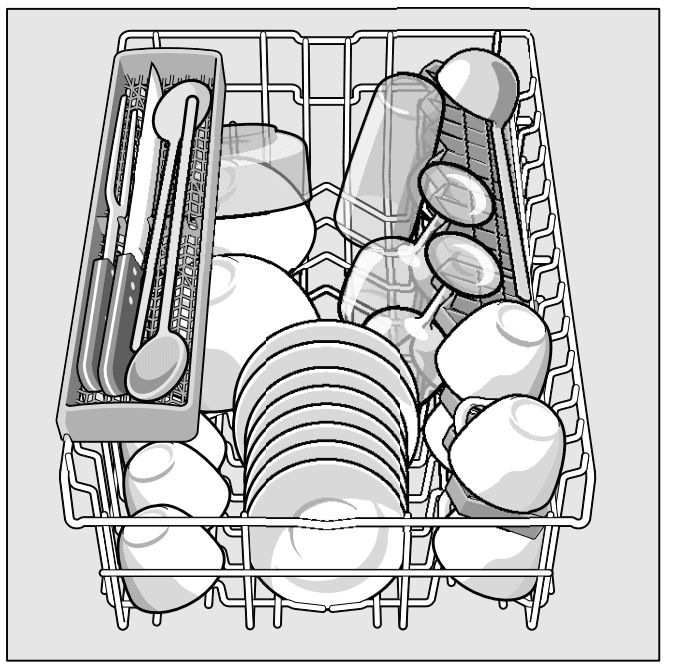
Pans
Bottom basket 27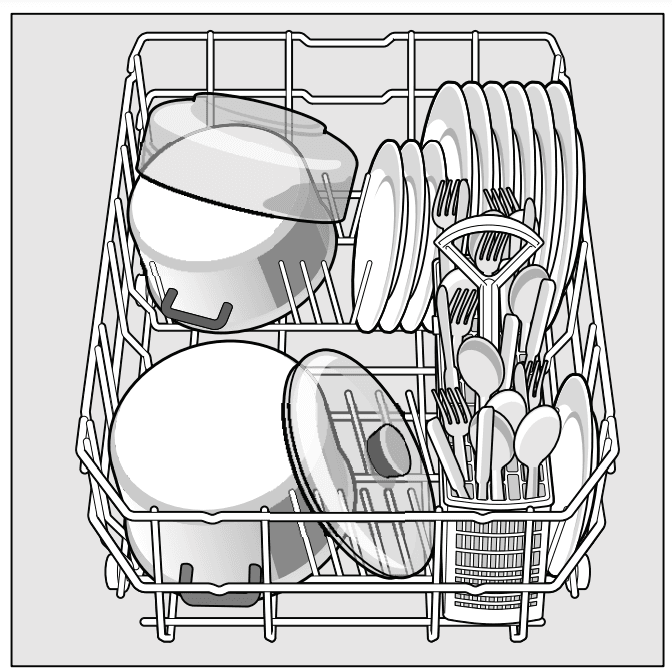
Tip
Heavily soiled utensils (pans) should be placed in the bottom basket. The more powerful spray jet provides a better dishwashing result.
Cutlery basket
You should always place cutlery unsorted with the points downwards. To prevent injuries, place long, pointed implements and knives on the knife shelf.
*Knife shelf
* depending on the model Long knives and other utensils can be arranged horizontally. You can remove the knife shelf to wash taller utensils.
Folding spikes *
* depending on the model The spikes can be folded down to improve the arrangement of pans, bowls, and glasses.
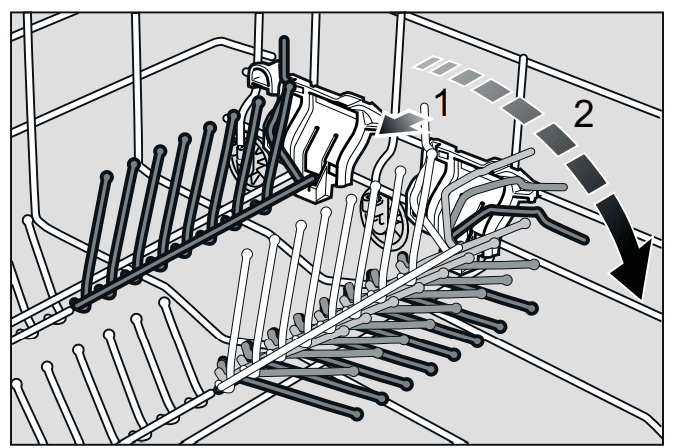
*Smalacesories holder
* depending on model Light-weight plastic accessories, e.g. cups, lids, etc. can be held securely in the small accessories holder
Top basket with upper and lower roller pairs
- Pull out the top basket 20 out.
- Remove the upper basket and reattach it to the upper (stage 2) or lower (stage 1) rollers.
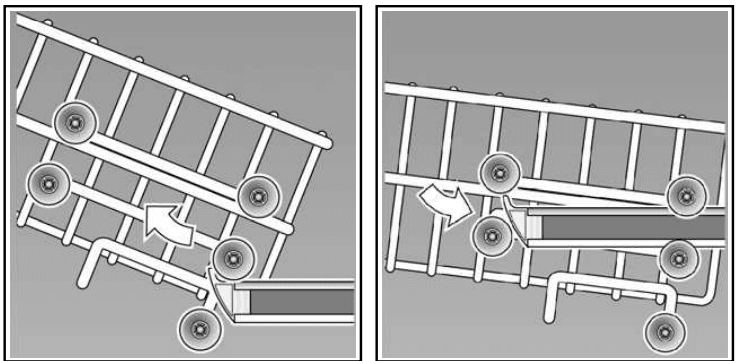
Detergent
You can use tablets as well as powder or liquid detergents for dishwashers but never use washing-up liquid. The dosage can be individually adjusted with powder or a liquid detergent according to the degree of soiling. Tablets contain an adequately large amount of active ingredients for all cleaning tasks. Modern, powerful detergents predominantly use a low-alkaline formulation with phosphate and enzymes. Phosphates bond the lime in the water. Enzymes break down starch and remove protein.
Phosphate-free detergents are less frequent. These have a slightly weaker lime bonding capacity and require a higher dosage. To remove colored stains (e.g. tea, tomato sauce), oxygen-based bleaching agents are usually used.
Note
To ensure a good washing result, always follow the instructions on the detergent packaging!
If you have further questions, we recommend that you contact the detergent manufacturers’ helpline.
Adding detergent
- If the detergent dispenser 30 is still closed, press lock 28 to open the detergent dispenser.
Pour detergent into the dry detergent dispenser 30. Dosage: see the manufacturer’s instructions
on the packaging. The graduated detergent dispenser 30 helps you add the correct amount of powder or liquid detergent. Usually, 20 ml–25 ml is adequate for normal soiling. If using tablets, one tablet is adequate. - Close the cover on the detergent dispenser. To do this, (1) push the dispenser cover shut and (2) press gently on the end until the catch engages audibly.

If using tablets, please refer to the manufacturer’s packaging where to put the tablets (e.g. cutlery basket,
detergent dispenser, etc.). Even if using tablets, ensure that the detergent dispenser cover is closed.
Tip
If the utensils are only lightly soiled, slightly less than the indicated amount of detergent is usually adequate. Suitable detergents and care products can be purchased online via our website or via customer service (see back page).
Combination detergent
Apart from conventional detergents (Solo), a number of products are offered with additional functions. These products contain not only the detergent but also rinse-aid and salt replacement substances (3 in1) and, depending on the combination (4 in 1, 5 in 1, etc.), additional components such as glass protection or stainless steel cleaner. Combination detergents function only up to a specific degree of hardness
(usually 26° Clarke). Over this limit salt and rinse-aid must be added. As soon as combined detergents
are used, the rinse program is adjusted automatically to ensure the best possible rinsing and drying results.
Overview of programmes
The max. the possible number of programs is illustrated in this overview. The corresponding programs and their arrangement can be found on the fascia.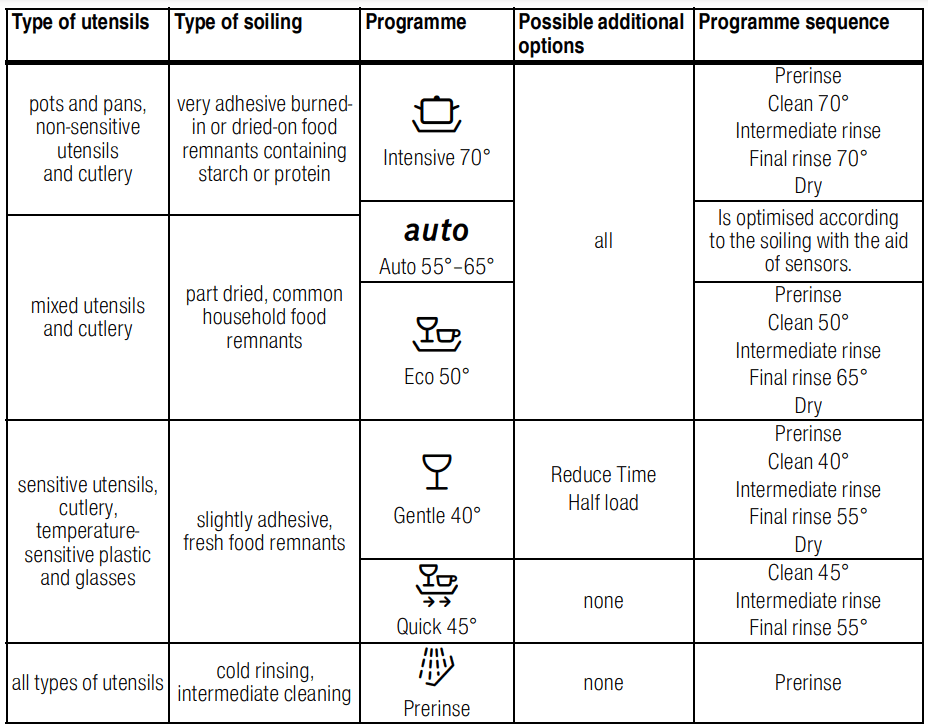
Installation
The dishwasher must be connected correctly, otherwise, it will not function properly. The specifications for the inlet and outlet as well as the electrical connected loads must correspond with the required criteria as specified in the following paragraphs or in the installation instructions. Install the appliance in the correct sequence:
- Checking appliance on delivery
- Installing the appliance
- Waste water connection
- Fresh water connection
- Electrical connection
Safety instructions
- Install and connect the appliance according to the installation and assembly instructions.
- Prior to installation, disconnect the dishwasher from the power supply.
- Ensure that the protective conductor system of the domestic supply has been correctly installed.
- The electrical connection conditions must correspond with the specifications on the dishwasher
rating plate 9*. - If the power cord of this appliance is damaged, it must be replaced with a particular power cord.
To prevent injury, the power cord may be replaced by customer service only. - If the dishwasher is installed in a high-sided unit, the unit must be secured properly.
Delivery
Your dishwasher has been checked thoroughly in the factory to ensure that it is in working order. This may cause small water stains. These will disappear after the first wash cycle.
Technical specifications
- Weight: max. 53 kg
- Voltage: 230 V, 50 Hz
- Connected load: 2,3 kW
- Fuse: 10/13 A
- Water pressure: at least 0.05 MPa (0.5 bar), maximum 1 MPa (10 bar). At a higher water
pressure: connect the pressure-reducing valve ahead. - Inlet rate: minimum 10 liters/minute
- Water temperature: cold water; hot water max. temperature 60 °C.
Installation
The required installation dimensions can be found in the installation instructions. Level the appliance with the aid of the height-adjustable feet. Ensure that the appliance is situated securely on the floor.
- A built-under or integrated appliance that is installed subsequently as a free-standing appliance must be secured to prevent it from overturning, e.g. by screwing it to the wall or by installing it under a continuous worktop that is screwed to adjacent cupboards.
- The appliance can easily be installed in a fitted kitchen between wooden and plastic walls.
Waste-water connection
- The required work sequence can be found in the installation instructions. If required, fit a siphon with a drainage connection.
Connect the waste-water hose to the drainage connection of the siphon with the enclosed parts. Ensure that the drainage hose is not kinked, crushed, or twisted and that there is no cover plate in the drainage to prevent the waste water from flowing out!
Fresh water connection
- Connect the fresh water connection to the tap according to the installation instructions with the enclosed parts. Ensure that the freshwater connection is not kinked, crushed, or twisted.
- When replacing the appliance, always use a new water supply hose.
Water pressure: at least 0.05 MPa (0.5 bar), maximum 1 MPa (10 bar). At a higher water pressure: connect the pressure-reducing valve ahead.
Inlet rate: minimum 10 liters/minute
Water temperature: cold water preferred; hot water max. temperature 60 °C.
Removing the appliance
Also, observe the sequence of work steps here.
- Disconnect the appliance from the power supply.
- Turn off the water supply.
- Disconnect the waste water and fresh water connections.
- Loosen fastening screws for the furniture parts.
- If fitted, remove the base panel.
- Pull out the appliance, carefully pulling the hose behind.
Packaging
All plastic parts of the appliance are identified with internationally standardized abbreviations (e.g. >PS< polystyrene). Therefore, plastic waste can be sorted out when the appliance is being disposed of.
Please follow the safety instructions under “Delivery”.
Old appliances
Please follow the safety instructions under “Disposal of your appliance”. This appliance is identified
according to the European guideline 2002/96/EC on waste electrical and electronic equipment
- WEEE. The guideline specifies the framework for an EU-wide valid return and re-use of old appliances.
For more manuals by Bosch, visit ManualsLibraryy
Bosch Dishwasher-FAQs
What is the best setting for a Bosch dishwasher?
The Auto cycle is the best choice for everyday dishwashing, as it automatically adjusts water usage and temperature for optimal cleaning.
What temperature does a Bosch dishwasher use?
The wash temperature typically ranges between 150-160°F, depending on the selected cycle.
Which dishwasher mode should I use?
1. Pre-wash: Helps eliminate the need for hand rinsing and uses less water.
2. Delicate cycle: Best for fragile items like glassware and crystal, using lower temperatures and gentler water pressure.
What is the most common problem with a Bosch dishwasher?
A frequent issue is poor cleaning performance, which may result in dirty dishes, residue on glassware, or leftover food particles. Regular maintenance and proper loading can help prevent this.
Can I run my Bosch dishwasher empty?
Yes, running an empty cycle is recommended for maintenance. Start the longest, hottest wash cycle, and after 30 minutes, add dishwasher descaler to the bottom of the dishwasher. Let the cycle complete, then run another wash cycle without detergent.
What does the salt symbol mean in a Bosch dishwasher?
The salt symbol (S-shaped icon) indicates that dishwasher salt needs to be refilled. This helps soften hard water and prevent limescale buildup on dishes and the appliance.
How long is the normal cycle on a Bosch dishwasher?
The Normal Wash Cycle typically runs for 130-135 minutes.
Does a Bosch dishwasher require hot water?
Bosch dishwashers can operate without a direct hot water connection. However, unless using a solar or energy-efficient heating system, it is recommended to connect the dishwasher to a cold water supply.
How do I set the temperature on my Bosch appliance?
Press the temperature setting button repeatedly until your desired temperature is displayed. The last selected value will be saved automatically.

